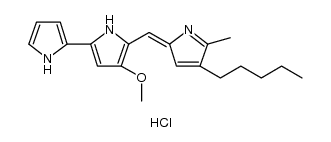| Description |
Prodigiosin (Prodigiosine) hydrochloride is a red pigment produced by bacteria as a bioactive secondary metabolite. Prodigiosin hydrochloride is a potent proapoptotic agent, and inhibits Wnt/β-catenin pathway. Prodigiosin hydrochloride has antibacterial, antifungal, antiprotozoal, antimalarial, immunosuppressive, and anticancer properties[1][2].
|
| In Vitro |
Prodigiosin (25-500 nM; 24 hours) treatment reduces the viability of breast cancer cells, with IC50 values at 48 h of 62.52 nM in MDA-MB-231 cells and 261.2 nM in MDA-MB-468 cells[1]. Prodigiosin (25-500 nM; 24 hours) treatment significantly reduces the levels of phosphorylated LRP6 and DVL2, active β-catenin, and total β-catenin. Prodigiosin noticeably inhibits the phosphorylation of GSK3β at Ser9 in HEK293T cells, which is indicative of an increase in GSK3β activity[1]. Prodigiosin can inhibit proliferation and induce apoptosis in breast cancer cells[1]. Prodigiosin (25-500 nM; 24 hours) treatment dose-dependently blocks Wnt signaling activated by Wnt1, Wnt3, Wnt1/LRP6, Wnt3/LRP6, and Dishevelled 2 (DVL2) in transfected HEK293T cells. Prodigiosin treatment inhibits Wnt3A-CM-induced transcription in a dose-dependent manner. Prodigiosin inhibits transcription of the SuperTopFlash reporter activated by either Wnt transfection or Wnt3A treatment[1]. When applied to cultures of chytrid fungi Batrachochytrium dendrobatidis and B. salamandrivorans, Prodigiosin causes significant growth inhibition, with MIC values of 10 μM and 50 μM, respectively[2]. Cell Proliferation Assay[1] Cell Line: MDA-MB-231 and MDA-MB-468 cells Concentration: 10 nM, 25 nM, 50 nM, 100 nM, 250 nM, 500 nM, 1000 nM, 2500 nM, 5000 nM Incubation Time: 24 hours, 48 hours Result: Reduced the viability of breast cancer cells, with IC50 values at 48 h of 62.52 nM in MDA-MB-231 cells and 261.2 nM in MDA-MB-468 cells. Western Blot Analysis[1] Cell Line: HEK293T cells Concentration: 50 nM, 100 nM, 250 nM, 500 nM Incubation Time: 24 hours Result: Significantly reduced the levels of phosphorylated LRP6 and DVL2, active β-catenin, and total β-catenin.
|
